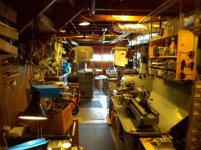Jon_Spear
Hot Rolled
- Joined
- Aug 26, 2004
- Location
- San Francisco, CA
I have just finished replacing all of the old incandescent-style light bulbs in my home shop, for the second time. (Several years ago, when there were price subsidies for the compact fluorescent light bulbs (CFL), it was cheap for me to change from the old incandescent lamps.) Now, I have installed the new LED light bulbs, which are even more energy efficient and longer lasting than the CFLs.
Even though most commercial shops use other larger light fixtures than a home shop, you still might have individual lamps for task lighting on each machine. The new LED light bulbs are great for those, because (unlike incandescent lamps) they are insensitive to vibrations and shock.
Anyway, I tried a bunch of different brands of LED light bulbs, and I have found two favorites, which I prefer over other brands.
The first is CREE brand, 60W replacement, dimmable, in soft white color, which is available in a 6-pack from Home Depot. Here is a currently working link: Cree 60W Equivalent Soft White (2700K) A19 Dimmable LED Light Bulb (6-Pack)-BA19-08027OMF-12DE26-2U100 at The Home Depot
The second is the FEIT, 40W replacement (using 7.5W), which is available in a 3-pack, from Amazon.com: Amazon.com: Feit 7.5 Watt A19 Dimmable LED Light Bulbs 3-Pack (equiv to 40 watts): Health & Personal Care
I like the "dimmable" LED lights because their circuits do not delay turning on the light. Also, I personally prefer working under lighting that is the color of "warm" white or "soft" white bulbs.
If anybody else has different recommendations, please share.
Even though most commercial shops use other larger light fixtures than a home shop, you still might have individual lamps for task lighting on each machine. The new LED light bulbs are great for those, because (unlike incandescent lamps) they are insensitive to vibrations and shock.
Anyway, I tried a bunch of different brands of LED light bulbs, and I have found two favorites, which I prefer over other brands.
The first is CREE brand, 60W replacement, dimmable, in soft white color, which is available in a 6-pack from Home Depot. Here is a currently working link: Cree 60W Equivalent Soft White (2700K) A19 Dimmable LED Light Bulb (6-Pack)-BA19-08027OMF-12DE26-2U100 at The Home Depot
The second is the FEIT, 40W replacement (using 7.5W), which is available in a 3-pack, from Amazon.com: Amazon.com: Feit 7.5 Watt A19 Dimmable LED Light Bulbs 3-Pack (equiv to 40 watts): Health & Personal Care
I like the "dimmable" LED lights because their circuits do not delay turning on the light. Also, I personally prefer working under lighting that is the color of "warm" white or "soft" white bulbs.
If anybody else has different recommendations, please share.


 but I will be interested in those at that time.
but I will be interested in those at that time.
